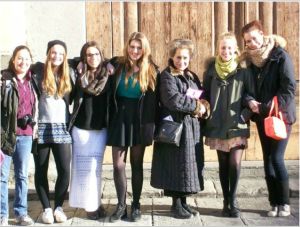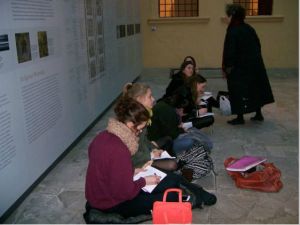In 1995, I visited Florence for the first time as the lucky recipient of a scholarship from the Dante Alighieri  Society, which enabled me to spend one month at the British Institute studying Italian.
Society, which enabled me to spend one month at the British Institute studying Italian.
I rubbed the nose of the famous wild boar in the Mercato Nuovo, hoping that I would return, but had little idea that I would be bringing my LVI Form History of Art students with me almost twenty years later.
We began our first-hand study of the art and architecture of Early Renaissance Florence by exploring Brunelleschi’s Santo Spirito which exemplifies the architect’s achievement of harmony and equilibrium through the artful use perspectival devices and the vocabulary of the antique.
We moved on to Santa Maria del Carmine to witness Masaccio’s revolutionary history painting: The Tribute Money which contrasted greatly with the feminine world of Ghirlandaio’s Life of the Virgin and Life of John the Baptist located in Santa Maria Novella, burial place of the noble Florentine, Giovanna Tornabuoni, whose image appears in the frescoes.
Saturday afternoon’s focus was on sculpture and it was easy to see why Ghiberti’s Gates of Paradise were  moved from their original location on the doors of the Baptistery to the safety of the Cathedral’s museum.
moved from their original location on the doors of the Baptistery to the safety of the Cathedral’s museum.
These idealised bronze and gilded relief panels that stupefied even Michelangelo could not have been more different from the rugged naturalism of Donatello’s Mary Magdalene.
On Sunday, further time was spent exploring Donatello’s varied styles and his exploitation of marble and bronze.
Leaving the Bargello we arrived at the Medici family’s former centre of administration: The Uffizi. We remembered the need to consider the reasons for such cultural endurance when faced with Boticelli’s enormous and beguiling manifestoes of Neo-Platonism: The Birth of Venus and Primavera.
The Venetian medium of painterly forms and luminous colour proved to be equally enigmatic in the timeless insouciance of the Venus of Urbino.
We then arrived at Santa Croce to view another statement of power that on this occasion belonged not to the Medici but to their bitter rivals – the Pazzi.
Given the context of such murderous feuding it is a paradox that The Pazzi Chapel exemplifies the serenity that Brunelleschi achieved through his use of sacred geometry and proportional planning.
In the evening, we took a train to the Medieval university town of Pisa. The white marble of the Romanesque complex of baptistery, tower and cathedral glowed with a mysteriously disorientating white light and it was clear to see why the ‘piazza dei miracoli’ would have attracted so many pilgrims during the middle ages. On Monday, we made our final stop at the Medici Palace.
The fortress like exterior not only conceals an elegant classical courtyard but, secreted in the deep regular spaces of the interior, Benozzo Gozzoli stretched the lustrous properties of fresco to its limits by simultaneously evoking a golden tapestry of Medici pageantry and vision of heavenly Jerusalem in the family’s private chapel.
It is always sad to leave Tuscany, but I am certain that the excellent notes that were taken by the girls during their first-hand observations will prove essential during the coming months of revision, as will the memories of the aroma of Italian coffee, perfume and rosemary.